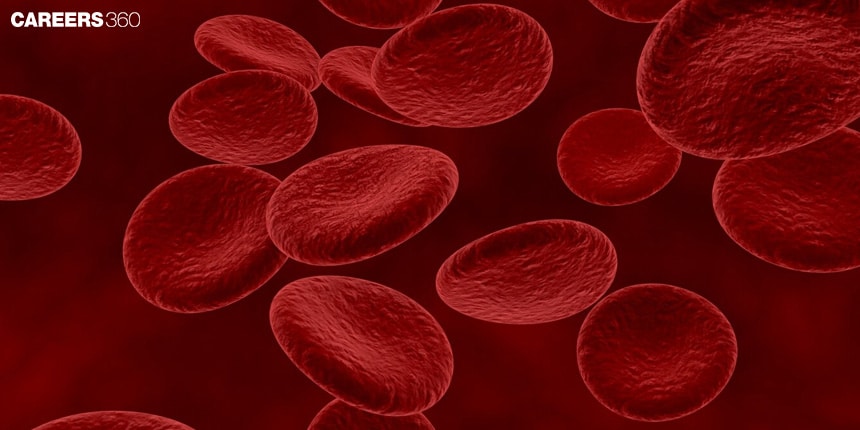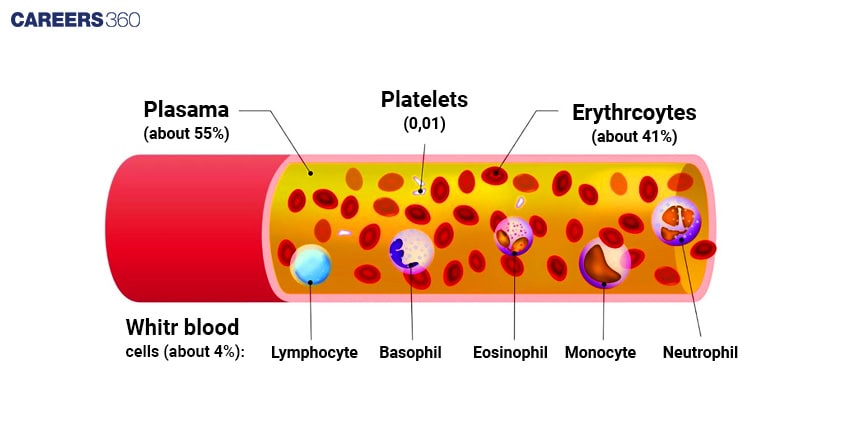Components of Blood and their Functions
What Is Blood?
Blood is an essential fluid in the human body that carries out some essential functions for survival. It comprises different elements that work together and help transfer oxygen and nutrition, remove wastes, and provide immunity to diseases. The knowledge about blood components is, therefore, very important in understanding its role in health and disease.
NEET 2025: Mock Test Series | Syllabus | High Scoring Topics | PYQs
NEET Important PYQ's Subject wise: Physics | Chemistry | Biology
New: Meet Careers360 B.Tech/NEET Experts in your City | Book your Seat now
- What Is Blood?
- Plasma
- Red Blood Cells (RBCs)
- White Blood Cells (WBCs)
- Platelets
- The Video Recommended On The Components Of Blood

The major four parts include plasma, RBCs, WBCs, and platelets. All these components have certain specified purposes and features to make one complete circulatory system.
Plasma
Plasma is considered to be the liquid fraction combined with the cellular fractions in blood and is composed of about 55%. It provides a medium for carrying many substances.
Composition Of Plasma
Water: 90-92%
Proteins: albumins, globulins, fibrinogen
Nutrients: glucose, amino acids, lipids
Electrolytes: sodium, potassium, calcium, and magnesium
Waste products: urea, creatinine
Hormones and enzymes
Functions Of Plasma
Transport medium for nutrients and waste
Holds the blood pressure and volume
Critical proteins for blood clotting and immune response
Red Blood Cells (RBCs)
Red blood cells form the majority of blood cells. They are oval, and their main role is to assist in oxygen and carbon dioxide transport.
RBC Structure
Biconcave disc shape
Mature RBCs have no or almost nonexistent presence of a nucleus.
Contains respiratory pigment in the form of haemoglobin.
Functions Of RBCs
Carry oxygen from lungs to tissues
Carry carbon dioxide from tissues to lungs
RBC Lifespan And Production
Erythropoiesis occurs in the bone marrow.
Life expectancy of about 120 days.
Decomposition and recycling in the spleen and liver.
White Blood Cells (WBCs)
WBCs are an integral part of your immunity system. They comprise the defence of our body against different infections and alien invaders.
Types Of WBCs
WBCs are divided into:
Neutrophils
First responders to bacterial infection and inflammation.
The pathogen is ingested and digested in a process called phagocytosis.
Lymphocytes
T cells directly attack infected or cancerous cells of the body.
B cells produce antibodies that target specific pathogens.
Monocytes
They differentiate into macrophages and dendritic cells in tissues.
Their main role includes the phagocytosis and presentation of antigens to T cells.
Eosinophils
The cells fight infections caused by parasites and allergic reactions.
It releases enzymes that will destroy parasites.
However, these enzymes are controlled during an inflammatory response.
Basophils
Releases histamine during allergic reactions and asthma.
It is involved in inflammatory responses and parasitic infections.
Functions Of WBCs
Immune response and defence against pathogens.
Phagocytosis and antibody production.
Allergic reactions and inflammatory responses.
WBC Count And Clinical Significance
Normal Ranges: Adults: 4,000 to 11,000 cells per microliter of blood
Children: Varies with age, generally higher than for adults.
High WBC Count (Leukocytosis)
Can indicate infections, inflammation, stress, leukaemia, tissue damage, or certain medications.
Symptoms may include fever, fatigue, weight loss, or easy bruising.
Low WBC Count (Leukopenia)
- Can indicate bone marrow disorders, autoimmune diseases, severe infections, certain medications, or malnutrition.
- Symptoms may include increased susceptibility to infections, fever, chills, or sweating.
Platelets
Small, disc-shaped cell fragments and platelets play a very significant role in blood clotting and wound healing.
Structure Of Platelets
Small, disc-shaped cell fragments
Origin from megakaryocytes in the bone marrow
Role Of Platelets
Blood coagulation or hemostasis
Maintenance of vascular integrity and wound healing.
Platelet Count And Disorders
Normal ranges
Conditions like thrombocytopenia, thrombocytosis, etc.
Diagram: Components Of Blood

Conclusion
Blood is a complex tissue that contains, within it, very different components with vital functions to the human body, allowing for the maintenance of health and life. Plasma, RBCs, WBCs, and platelets have very special roles, which help in nutrient transport, immune defence, and blood clotting. The overall consideration of blood components makes appreciation of how blood sustains general health easy and shows some medical conditions related to it. Further study on blood components may help one to delve deeper into the important role blood plays in the body.
The Video Recommended On The Components Of Blood
Frequently Asked Questions (FAQs)
Blood consists of plasma, red blood cells, white blood cells, and platelets.
Plasma transports nutrients, hormones, and waste products. It is also responsible for the maintenance of blood pressure and volume.
RBCs contain haemoglobin, which binds to oxygen and carries it to tissues in the body.
WBCs form an integral part of the immune response for fighting infection and offering protection against the body from foreign entities or invaders.
Platelets play a very essential role in the process of blood clotting and wound healing.
Also Read
29 Nov'24 01:19 PM
27 Nov'24 07:39 PM
27 Nov'24 07:15 PM
27 Nov'24 05:11 PM
26 Nov'24 08:14 PM
26 Nov'24 06:50 PM
26 Nov'24 05:51 PM
26 Nov'24 04:44 PM
26 Nov'24 03:52 PM
26 Nov'24 02:55 PM